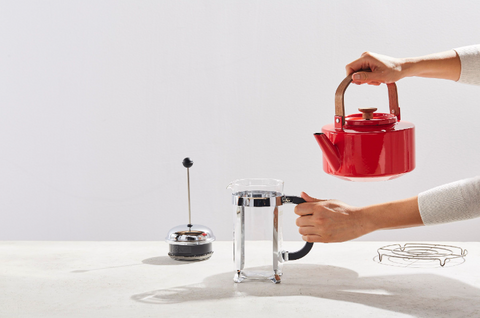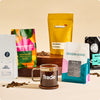How to Make French Press Coffee
Make the perfect French Press coffee at home every time.
A classic for a reason, the French Press could hardly be easier to use. No worrying about how long it takes for water to flow through the coffee bed; it’s as easy as brewing a cup of tea. Once you know the proper water temperature, the ratio of liquid to grounds, and how long to brew your coffee, you’re well on your way to making French press coffee.
Because there’s no paper filter to stop them (just a stainless steel fine-mesh screen), tiny dissolved particles and essential oils from the coffee grounds end up in your cup and give the coffee a richer, fuller body. Wondering, “is French press coffee right for you?” If you’re a coffee drinker who’s into big-bodied coffees, the French press coffee maker might be the perfect brewer for you. That slightly oily feel and big body reflect the qualities of most dark roasts, so those are great in a French press. Ready to learn how to use a French press to create a delicious cup of coffee? Let’s dive in.
What You Need
- A French Press, any brand will do. We love the Clara from Fellow.
- Spoon or stirrer
- A kettle
- A scale (optional)
- 35 oz / 1,000 ml of boiling water
- 2.5 oz / 65 g of coarsely ground coffee. Don't have a grinder? We can grind it for you!
Getting Started
1. Warm with Water
Preheat your French press coffee maker by filling it with hot water from a kettle. Whether you have a classic
glass French press or stainless steel model, this step will make sure the whole coffee maker stays warm during the entire brew process — ensuring you get all those tasty flavors out of the grounds and into your cup. Temperature is one of the key variables in consistently brewing the best coffee, so you do not want your hot water hitting a cold coffee brewer and immediately cooling down.
While you wait about 30 seconds, now is a great time to grind your coffee. Because the French press is an immersion brewing method (meaning the coffee is completely submerged in water and stays in contact until the coffee brewing process is done), you want a very chunky, coarse grind size. The larger the surface area, the longer it takes for the water to extract the delicious stuff out of the coffee beans.
If you are using a grinder for your French press coffee, you should know the differences between a
burr grinder vs blade grinder. If you use a burr grinder (which we very much recommend for its vastly more even grind size), you’ll want the higher number settings. If you use a blade grinder, just don’t grind for as long as you would for, say, a drip machine. If you’re getting your coffee beans pre-ground at a shop, odds are you’ll just be able to ask for it to be ground for a French press, but if all else fails just remember the word “coarse”. Empty the hot water from your French press before continuing; you’ll be using fresh water to brew.
2. Add Coffee Grounds
Whatever delicious coffee you’ve chosen to brew, now is the time to add that coarsely ground coffee to the carafe. Remember to measure! The right coffee-to-water ratio is one of the keys to a consistent, delicious cup, no matter the
coffee processing method. For our recipe, we like to use around 15 grams of water for each gram of coffee. Here are some helpful tips to keep in mind when measuring:
- One milliliter of water weighs exactly one gram, so if you’re using a scale you can measure everything really easily by placing your carafe onto the scale before pouring
- You can measure your water in a measuring cup as well. Just make sure you consistently use the same coffee scoops every time and measure them the same way.
- If you usually measure a level tablespoon, but one day decided to measure a heaping tablespoon, just pay close attention to how high you’re filling the French press, to make sure your brews are that much more consistently tasty.
3. Bloom to Enhance
Ladies and gentlemen, start your timers. Pour your water around in a spiraling motion, or really any pattern that ensures your water is evenly submerging all of the grounds. If you see any dry spots up top, try and aim for them with your stream of water. You want to get all the grounds wet at as close to the same time as possible, so the water starts extracting flavor from them simultaneously. That even extraction will make the coffee taste more balanced and delicious. You may notice your grounds “growing” or bubbling in the hot water. This process is called blooming coffee, and it helps prepare the grounds to be brewed to perfection. That first pour helps release gases like carbon dioxide from the coffee, which then allows the rest of the water you pour to fully penetrate the grounds and extract all of that tasty stuff more evenly. Let that water work its magic and wait until the timer reads 30 seconds before continuing.
4. Fill & Stir
Fill the carafe the rest of the way with hot water and give the coffee a gentle stir. This will ensure that crust of the grinds that has formed on top of your brew gets integrated into the water and doesn’t just hang out up top.
 You don’t want to stir too violently, though, because that will agitate the grinds and speed up the extraction, which might release some bitter flavors (plus, while variables like coffee temperature and time are really easy for us to control, agitation is super hard to measure). Place the lid on the French press and, if necessary, press the plunger down just a bit so that the mesh filter is just touching the top of the hot water, which will also help keep all the grounds submerged. Resist the urge to press all the way down, though. In a French press, you want to be brewing at a ratio of around fifteen parts water to one part coffee, which is just slightly stronger than the traditional drip coffee brewing ratio. The metal mesh filter (compared to the paper filter in many other brew methods) doesn’t stop the oils of the coffee from getting into your cup, and that extra bit of strength helps the flavors cut through those oils. That said, if you brew your French press at a ratio of fifteen to one and the coffee tastes stronger or weaker than you prefer, feel free to use more or less water next time. That’s part of the fun of brewing coffee at home – you can experiment. Some days you may enjoy a lighter coffee and others a stronger coffee. In fact, if the coffee seems too strong for you, simply add a little water to your finished morning coffee cup after the fact (sadly, if the coffee seems too weak, you can’t really take water out after the fact).
You don’t want to stir too violently, though, because that will agitate the grinds and speed up the extraction, which might release some bitter flavors (plus, while variables like coffee temperature and time are really easy for us to control, agitation is super hard to measure). Place the lid on the French press and, if necessary, press the plunger down just a bit so that the mesh filter is just touching the top of the hot water, which will also help keep all the grounds submerged. Resist the urge to press all the way down, though. In a French press, you want to be brewing at a ratio of around fifteen parts water to one part coffee, which is just slightly stronger than the traditional drip coffee brewing ratio. The metal mesh filter (compared to the paper filter in many other brew methods) doesn’t stop the oils of the coffee from getting into your cup, and that extra bit of strength helps the flavors cut through those oils. That said, if you brew your French press at a ratio of fifteen to one and the coffee tastes stronger or weaker than you prefer, feel free to use more or less water next time. That’s part of the fun of brewing coffee at home – you can experiment. Some days you may enjoy a lighter coffee and others a stronger coffee. In fact, if the coffee seems too strong for you, simply add a little water to your finished morning coffee cup after the fact (sadly, if the coffee seems too weak, you can’t really take water out after the fact).
5. Wait for It
When the timer reads four minutes, your coffee is ready to drink! Finally, you can press that coffee plunger all the way down, until the coffee grounds are packed on the bottom. Careful not to push too hard — it’s better to press gently, so as to not over-agitate the coarsely ground coffee, which can lead to a few extra-bitter flavors winding up in your brewed coffee.
Don’t feel the need to press down on the grounds at the bottom like you’re trying to forcefully squeeze every last bit of flavor out of them. You already ground the coffee to a specific size and used time and temperature to gently coax those desired flavors out. Brute force won’t make it taste any better. Plus, even the sturdiest French press can only withstand so much force, and the last thing we want is a broken one.
6. Voila!
Pour the hot coffee from the French press into your coffee mug and you are good to go. Even if you don’t want to drink all the coffee right away, try not to leave any extra coffee in your French press for later. While the plunger is great for making the coffee easier to pour out, it doesn’t completely separate the coffee grounds from the liquid. So if the coffee sits in that French press too long, it will get bitter from over-steeping, as the water is still in contact with the coffee grounds through that mesh filter. If you want to slowly enjoy it throughout, say, a leisurely brunch, pour it into a separate carafe or pitcher. If you have any left over that you’re not going to get to within the hour, put it in a cup or jar and stick it in the fridge. Now you have iced coffee for when you return home.
FAQs
What grind size is best for French press coffee?
- For French press brewing, a coarse grind is ideal to prevent over-extraction and ensure a smooth, flavorful cup.
How much coffee should I use in a French press?
- A general guideline is to use one tablespoon of coffee per six ounces of water. Adjust to taste preferences for stronger or milder brews.
How long should French press coffee steep?
- Allow the coffee to steep for about 4 minutes before plunging the French press. Adjust steeping time based on desired strength.
Can I use pre-ground coffee for the French press?
- While freshly ground coffee is recommended for optimal flavor, pre-ground coffee can still produce a decent cup in a pinch. Just ensure it's a coarse grind suitable for French press brewing.
Is it necessary to preheat the French press before brewing?
- Preheating the French press with hot water helps maintain the brewing temperature, resulting in a more consistent extraction and better-tasting coffee.
Discover Quality Coffee with Trade
Elevate your at-home coffee brewing with Trade Coffee's exceptional coffee subscriptions and premium brewing equipment. At Trade, we're passionate about bringing you the finest beans from top roasters nationwide, ensuring every cup is a delightful experience.
With Trade, you can access a curated selection of freshly roasted beans tailored to your taste preferences. Our subscription service simplifies your coffee journey, delivering handpicked beans directly to your doorstep. Whether you prefer a light, medium, or dark roast, our extensive collection guarantees a perfect match for your palate.
Explore Premium Brewing Equipment
Enhance your coffee-making ritual with our range of high-quality brewing equipment. From classic French Presses to state-of-the-art coffee grinders, we offer tools to suit every brewing style. Elevate your home barista skills and craft barista-quality beverages with ease.








 You don’t want to stir too violently, though, because that will agitate the grinds and speed up the extraction, which might release some bitter flavors (plus, while variables like
You don’t want to stir too violently, though, because that will agitate the grinds and speed up the extraction, which might release some bitter flavors (plus, while variables like 

